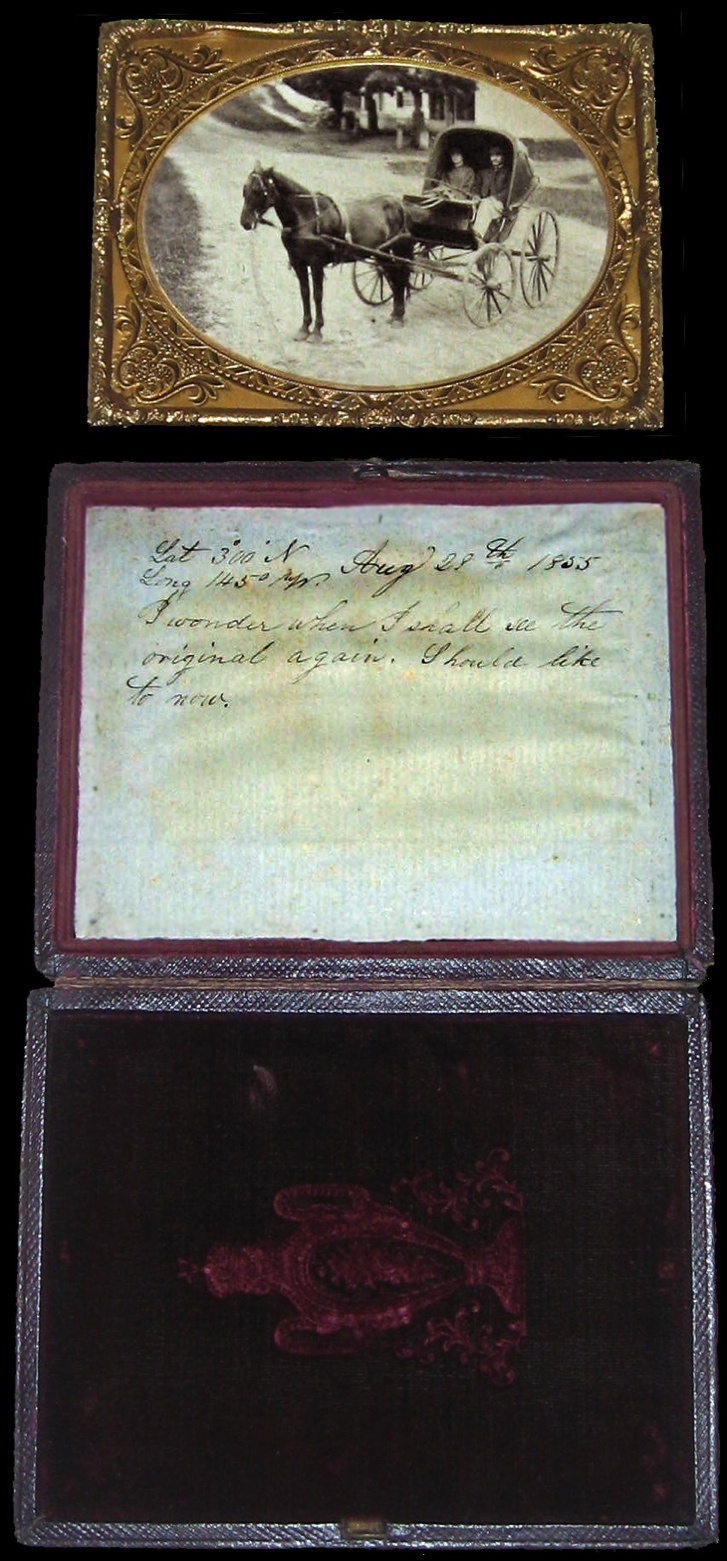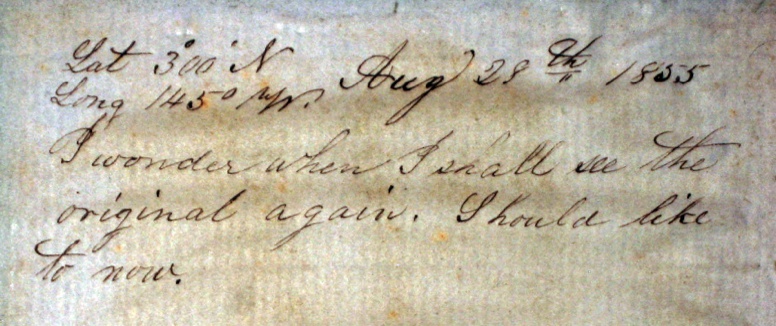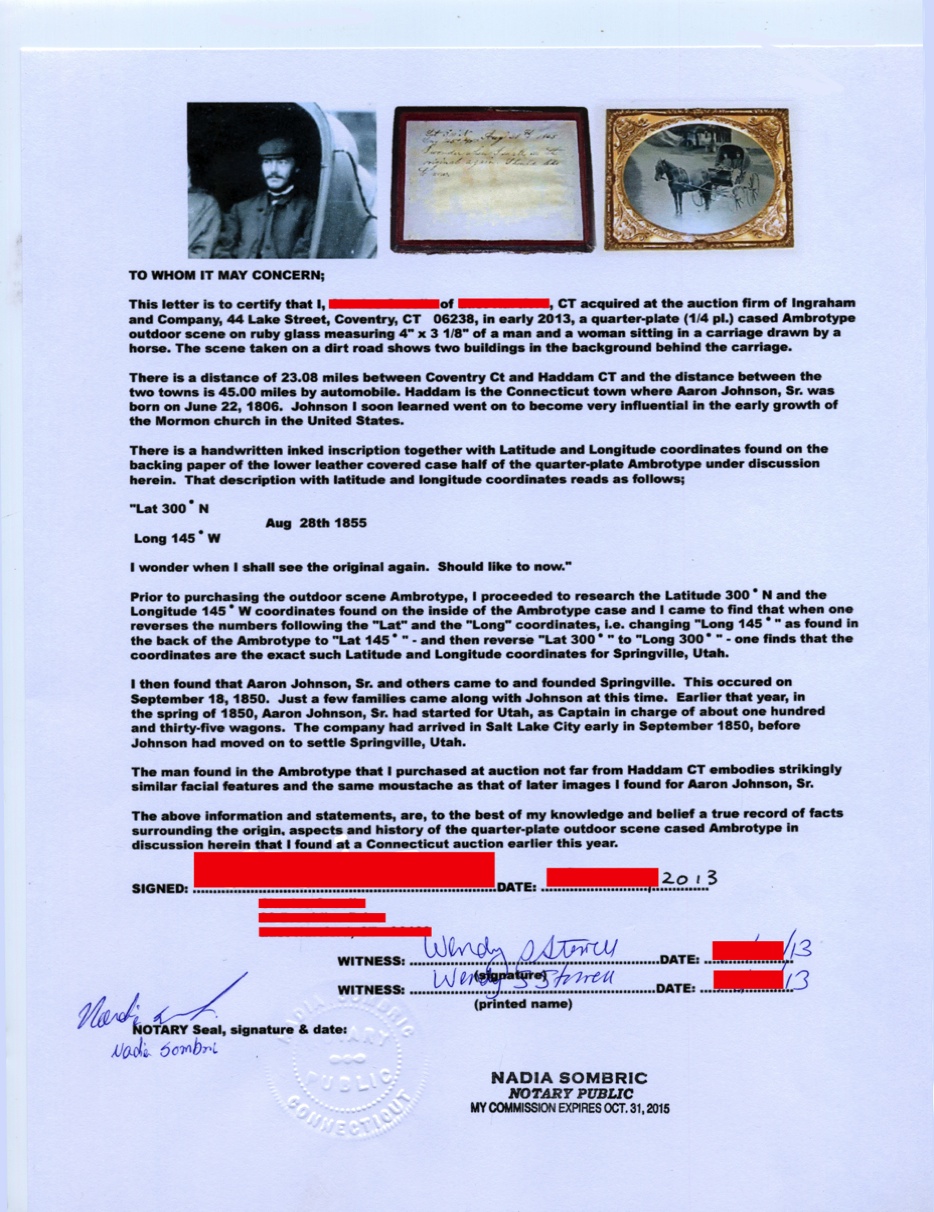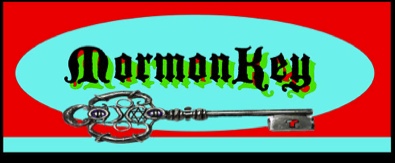
In early 2013, at a small country antiques and household auction in eastern Connecticut a curious photograph on glass housed in a delicate tinny brass frame, known as an Ambrotype - came to the attenton of one particular regular auction attendee that day.
In the case of this one particular quarter-plate sized Ambrotype depicting a mid 19th century outdoor scene of a man and a woman sitting in a horse drawn carriage in the middle of a dirt road - during the auction preview, the auction goer decided to 'pop-out' the Ambrotype image to see what might be behind it.
What's behind a 'hard case image'? A 'hard cased image' is the name collector's have given glass Ambrotype photographic images and the earlier Daguerreotypes on silver sensitized copper plates housed also in book shaped leather covered wood cases. Sometimes in the back of the image there is revealed more details about the image than first meets the eye. Collectors of 'hard case images' universally know that more details can often be found on the paper case liner inside the case behind the image. Also, sometimes an additional slip of paper may be found inside the case behind the image, or a lock of hair even.
Thus, in the case of this one particular 1/4 plate sized Ambrotype that surfaced among the items sold at the small eastern Connecticut auction in the beginning of 2013, what would prove to be some very significant data, was revealed. During the property auction preview period, an astute and inqusitive auction attendee copied down what was found inked on to the inside paper liner behind the image and went home to do some research on a computer before the auction's commencement.
The brown inked inscription found on the Ambrotype's inside paper case liner read as follows;
DISCOVERY AND INITIAL
AUTHENTICATION OF IMPORTANT
AMBROTYPE PHOTOGRAPH OF MORMON BISHOP LEADER AARON JOHNSON
Once at home and sitting before a computer, the curious coordinates of:
"Lat 300° N" and "Long 145° W"
- was typed in during a Internet web search and peculiar specifications arose stating that the location was none other than that of Springville, Utah. However, the specifications that arose were not precisely explained as to why Springville, Utah came up typing in "Lat 300° N" and "Long 145° W".
This is because it was also found that Springville, Utah actually had a different latitude / longitude designation of:
Latitude = 40.1652° N
Longitude = -111.6108° W
Never-the-less, the location of Springville, Utah was now a primary part of the initial search and the date of "August 28, 1855" found in the inked inscription also acted as a further means of seeking to authenticate, at least for the moment - one of two personages found pictured in the image.
Further Internet web searches using the inscriptions of "Springville, Utah" and "August 28, 1855," or just the date "1855" being added to the mix, quickly yielded the name and images of Mormon Aaron Johnson, who actually founded and settled Springville, Utah. Mormon Territorial Governor Brigham Young had directed Aaron Johnson to engage in Springville's settlement and founding in 1850. This was directly in following to having brought down 135 wagons fulls of Mormons to the new territor. With the appointment by Brigham Young, Aaron Johnson was ordained as the first Mormon Bishop at Springville and also acted as founding postmaster there. This was all beside being an Brigader General over Utah Territory's militia for many years, and having actually once been the head of the 'Mormon Militia' back in Nauvoo, Illinois. It was here where Aaron Johnson was very close to Prophet Joseph Smith. In fact, as head of the Mormon Militia back in Ilinois, it was Aaron Johnson who had guarded and escorted Joseph Smith and his brother Hyrum Smith to the Carthage jailhouse awaiting trial, only to become where the two would meet their deaths.
The auction attendee finally ran across several photographic likenesses of Aaron Johnson on the Internet and immediately recognized that all had a very striking resemblance with the man in the 1/4 plate Ambrotype he had just seen back at the auction house. There was one thing that predominately stood out and that was the signature moustache found worn by the man in the Ambrotype with all of those of the similar looking Aaron Johnson images found online on the Internet.
When the outdoor scene Ambrotype came up on the auction block back at the auction sale, a successful bid was able to secure the image.
Coming to the attention of author and historian Richard Warren Lipack, the acquisition of the 1855 Ambrotype of the still presumed to be Aaron Johnson, was made. This action awaited further investigations and until proper paleographic comparative assessments could be commensed upon.
At the time of the 1855 image's acquisition by historian Richard Warren Lipack, he proceeded to document the acquisition and procurement of same by obtaining a signed affidavit from the 1855 image's original auction buyer attesting to where and when the 1855 image was found. That signed affidavit is shown below.
The above constitutes the signed affidavit attesting to the initial discovery and acquisition of the 1/4 plate Ambrotype of Aaron Johnson, founder and founding Bishop of Springville, Utah and also the area's first U.S. postmaster.
Representatives of the State of Utah Archives at Salt Lake City, Utah and the Brigham Young University Library at Provo as well, provided Utah State militia records and access to 1860's and 1870's photographic likenesses of Aaron Johnson, which too was provided. The resulting outcome from using these materials in-so-far as conducting a proper paleographic comparison and evaluation commenced forthwith and became a wholly formidable conclusion. The specific findings of same thus shall follow herein for one's personal perusal, evaluation, investigation, as well as edification.
After further investigations and discussions with representatives of the Brigham Young University, east coast based historian and researcher Richard Warren Lipack was informed that the "Longitude" and "Latitude" representations found inked on the Ambrotype's inner case lining actually revealed something else; something other than longitude and latitude. Rather, what the two designations actually represented was the physical street postal mailing address of the Aaron Johnson residence at the time back in 1855! Johnson, as he was the postmaster of Springville - the first actually , was probably the person and party who had developed this antique and novel method and arrangement of a numbered residence street addressing system.
Most fascinating is that this data likely stands to be the earliest extant evidence of the unique form of street mapping configuration initially placed and adopted in Springville. Moreover, it is a mapping configuration that stands as a current standard in most major areas in the state of Utah today.



(Courtesy: Richard Warren Lipack Collection)
"MORMONKEY: The Key to News and History of the Mormon Faith"


